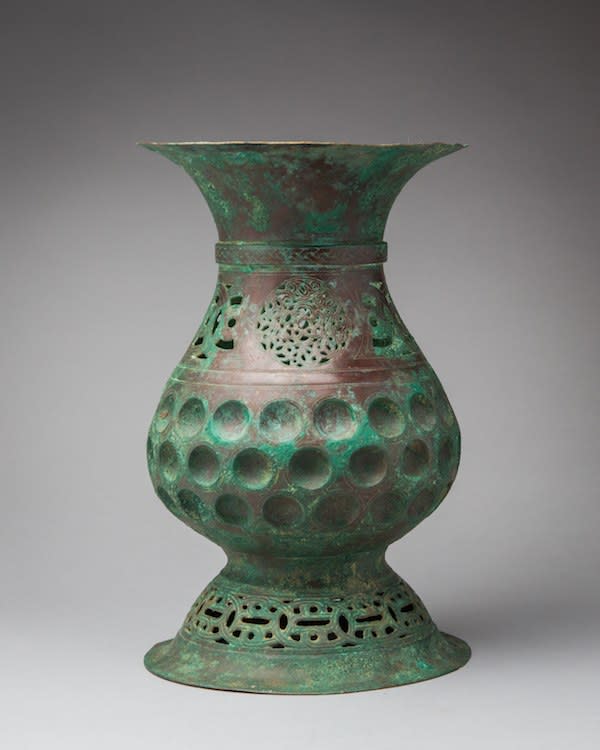Seljuk cast bronze Islamic incense burner, 11th Century CE - 12th Century CE
Bronze
10 x 6.5
MS.917
The Seljuk dynasty was of a Sunni Muslim dynasty of western Turkic origins that gradually became hugely influenced by the Persian language, culture, literature, art, and/or identity and contributed to...
The Seljuk dynasty was of a Sunni Muslim dynasty of western Turkic origins that gradually became hugely influenced by the Persian language, culture, literature, art, and/or identity and contributed to the Turko-Persian tradition in the medieval West and Central Asia, from 1037 to 1194 AD. The Seljuks established both the Seljuk Empire and the Sultanate of Rum, which at their heights stretched from Anatolia through Iran and were targets of the First Crusade.
Today, they are are considered as great patrons of Persian culture, art, literature, and language and are regarded as the ancestors of the present-day inhabitants of Azerbaijan, Turkey, and Turkmenistan.
Seljuk period cast bronze incense burner of typical baluster form, with a globular body over a large domed splayed conical foot, topped by a narrow- waisted neck terminating in an everted splayed rim. The rim is decorated by an incised row of Kufic script, on the shoulder features a tall openwork register of linked circular roundels intersperced by open worked whereas intertwined foliage motifs adorn the remaining surface. On the main body, three horizontal rows of sunken bosses.
The unusual shape of this vessel vaguely reminds contemporary ceramic baluster vases from China. The Central Asian rosette motif together with the occurrence of the endless knot would suggest a provenance further to the east of Iran, possibly in Transoxiana. The openwork design suggests its use as incense burner, as similar vessels were indeed used further to the East in China, for ceremonial purposes. This cast quarternary bronze (high tin copper alloy) baluster vase, in its simple yet refined decorative composure would seem to indicate a 12th century dating, possibly suggesting Transoxiana, rather than Iran, as its place of manufacture.
References: incense burners of a similar shape can be found in Jerusalem (Israel Museum B64.09.3749).
Today, they are are considered as great patrons of Persian culture, art, literature, and language and are regarded as the ancestors of the present-day inhabitants of Azerbaijan, Turkey, and Turkmenistan.
Seljuk period cast bronze incense burner of typical baluster form, with a globular body over a large domed splayed conical foot, topped by a narrow- waisted neck terminating in an everted splayed rim. The rim is decorated by an incised row of Kufic script, on the shoulder features a tall openwork register of linked circular roundels intersperced by open worked whereas intertwined foliage motifs adorn the remaining surface. On the main body, three horizontal rows of sunken bosses.
The unusual shape of this vessel vaguely reminds contemporary ceramic baluster vases from China. The Central Asian rosette motif together with the occurrence of the endless knot would suggest a provenance further to the east of Iran, possibly in Transoxiana. The openwork design suggests its use as incense burner, as similar vessels were indeed used further to the East in China, for ceremonial purposes. This cast quarternary bronze (high tin copper alloy) baluster vase, in its simple yet refined decorative composure would seem to indicate a 12th century dating, possibly suggesting Transoxiana, rather than Iran, as its place of manufacture.
References: incense burners of a similar shape can be found in Jerusalem (Israel Museum B64.09.3749).
